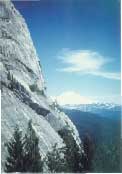
Questions?
Email us at: JandK@LivingGoldPress.com
 HOME
HOME

 |
Email us at: JandK@LivingGoldPress.com
|

In an area where mystery is omnipresent, here is yet another perplexing and unsolved puzzle of the ages: the Castle Crags petroglyphs, discovered several decades ago by two Dunsmuir high school students and the late Frank Bascom.
Castle Crags, just south of Mt. Shasta, is ages older than the ancient mountain itself. These glacier-polished crags are unrelated to the more recent volcanic activity of the mountain and are made up of granitic material which was formed some 225 mil�lion years ago far beneath the surface of the earth and later forced slowly upward through a blanket of serpentine and glacial debris by a process of fold-faulting.
Castle Crags, with its towering spires and domes, is surrounded by primitive backcountry and is now one of California's most enchanting state parks. A scenic overlook high within the park boasts an overall view that is literally staggering in its beauty -magnificent canyons far below, still-unspoiled whitewater rivers, alpine lakes, and to the north glacier-streaked Mt. Shasta looms, 14,162 feet of incredible brilliance.
Flowing through the lower slopes of Castle Crags is Little Castle Creek and it was in this area that the high school boys were hiking one sunny day. Tarrying awhile beside a huge cleft boulder, one of them casually brushed aside some loose material and was startled to find the impression of a human hand on the boulder, a man's hand. The imprint had been chiseled into the granite and filled with a red cement-like solution, used apparently for the purpose of keeping any growth of vegetation from covering the symbol.
Excitedly they hunted for more carvings and nearby found two more symbols, ser�pentine in form. Then on the opposite side of the boulder, they found another hand, smaller and more delicately molded, which obviously represented a female hand.
Hurrying home to relate their mysterious find, they returned shortly with Frank Bascom, who was associated with the U. S. Forest Service and also dabbled in archae�ology and geology. The boys led the way up Castle Creek canyon, on up the Mount Bradley road, then hiked along the banks of Castle Creek. Finally the threesome reached the graven rock. More searching revealed, in a willow clump, a second set of carvings which included two Maltese cross designs - one created in a zigzag line dec�orated with dots and the other composed of two E-like characters.
Intrigued, Bascom immediately reported the discovery to the Shasta National Forest officials and a third trip was made to the site. More carvings were found nearby. On a rock upstream, which measured about eight feet in height, were found a male and female hand and more petroglyphs. The palm of the male hand bore an engraving similar to a capital E, and the female hand bore a curious double triangle symbol. On the opposite side of the boulder they found the likeness of a bovine head.
Bascom, certain that they had made an important discovery, returned to the area accompanied by George Schrader (who represented the local U. S. Forest Supervisor) and other personnel from the U. S. Forest Service. This group investigated the fasci�nating petroglyphs. Bascom then wrote an article about the Castle Creek experiences in which he stated:
The fact stands out that the petroglyphs or symbols chiseled in the coarse granite rocks up Castle Creek show greater skill and symmetry and a higher degree of culture than any found elsewhere in different places of southwestern United States. The pet�roglyphs have been colored a reddish hue with some unknown liquid solution, and it was evidently used to keep any growth of vegetation from covering the symbols.
The people who did this work were no doubt artists possessing great skill. On what is now two large boulders there was at some remote time, one huge rock, which at some time was cleft asunder. The symbols are on the east side of these two rocks. Those on the rock to the south reveal a large man's hand, painted with some unknown stain. In the palm of the hand is chiseled the "all-seeing eye" and on the rock to the north is a beautifully-shaped woman's hand in whose palm is chiseled a form of the swastika (which is thought to be a very ancient symbol of the four rivers of life, or eternity; the swastika symbol is pre-Christian in origin and was found in the ruins of the lost continent of Lemuria (Mu) as well as in India, China and Tibet).
Were the symbols placed on the two rocks before or after the rock broke and sep�arated? On the rock to the north, the woman's hand is at the side and not in the cen�ter of the rock. In chiseling the rock, the natural thing would be to place such work in the center and not at the side of the rock. This might indicate that the symbols were cut into the rock prior to its separation.
On the heels of these remarkable petroglyph discoveries came various interpreta�tions. Letters were exchanged with the Department of Anthropology at the University of California; communications came from authorities at Stanford University; and from the Academy Press in New Jersey came a letter to Frank Bascom from Alvin Boyd Kuhn stating that he thought the symbols had been chiseled into the boulders by local Indians.
Bascom replied: 'This I doubt. In talking with the highest type of the older local Indians, they state this work was not chiseled by Indians. Therefore, we have to turn to another source. Dr. Julian Stewart shows in his book Petroglyphs of the United States (which sets forth all the petroglyphs found in this country by Indians) that the Indian and the Maya civilization started from a Lemurian colony, and stated that the Maya used ferric oxide, a red pigment, to deter erosion, and the pigment on the petroglyphs could be the same.�
Bascom added, "Churchward, in his 'Lost Continent of Mu' lists six of the symbols found at Castle Crags: the swastika, a form of the Maltese cross, the triangle, the all-seeing eye, the serpent and the three steps to the throne. He found these symbols engraved on clay tablets in the temples of India as they had existed in the sunken continent of Mu and I'd consider them authentic."
And so the controversy continued. Considering the age of Castle Crags, local per�sons including Bascom insisted that these mystic signs were carved into the granite rock in a prehistoric era, and these theories are supported by those who believe that Mt. Shasta area is, indeed, part of the last remaining portion of the vast continent of Lemuria which sank into the Pacific Ocean together with most of its ancient, advanced and highly skilled civilization.
The Castle Crags petroglyphs still remain a mystery. Who carved the delicate, intri�cate symbols into the hard, granite boulders and when and why, will probably always be just another mystery in an area where mysteries abound.